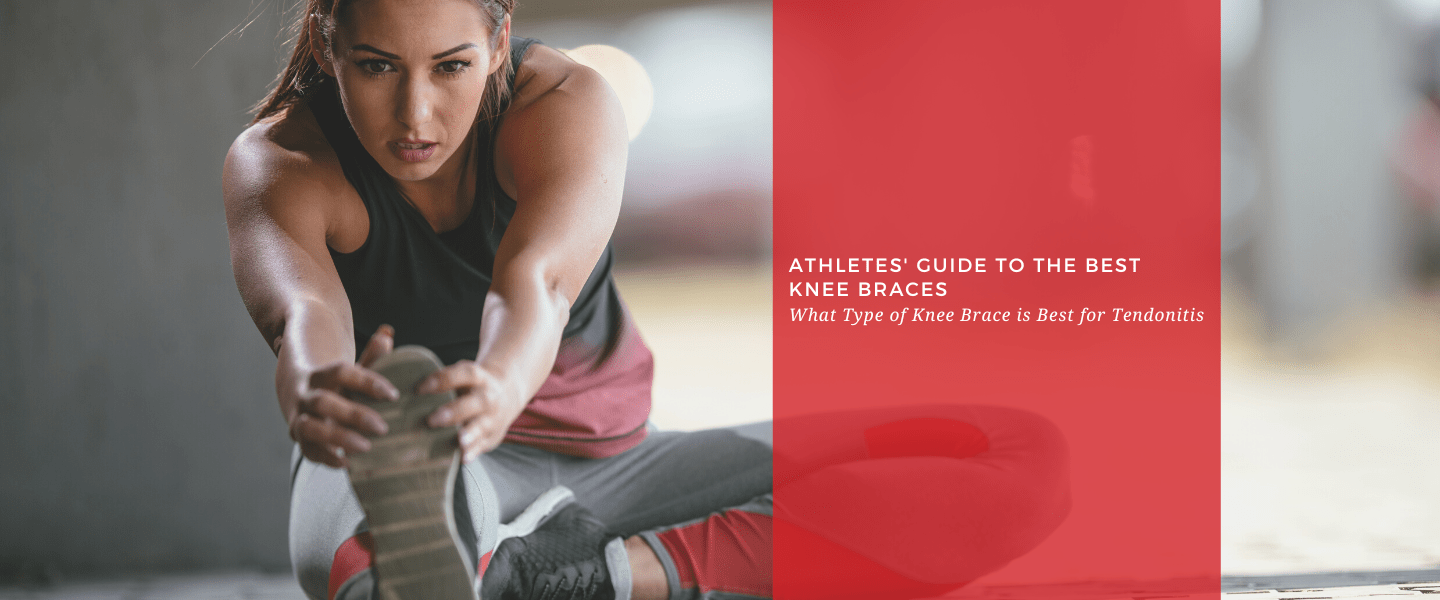With over 1 million orders

What Type of Knee Brace is Best for Tendonitis: Athletes' Guide to the Best Knee Braces
Attention athletes! Here's your playbook for selecting what type of knee brace is best for tendonitis. This insightful guide breaks down various types, their perks, and the game-changing impact they can have on your performance.
As an athlete, your body is your most important tool, and your knees are a vital part of that machinery. However, they can be vulnerable, especially to conditions like tendonitis. This inflammation of the tendons can cause significant pain and disruption, particularly impacting sports performance. Tendonitis can affect any tendon, but it's often the knees that bear the brunt in athletes due to the high level of stress and strain they endure. The key question for many is: what type of knee brace is best for tendonitis? Let's delve into that.
Understanding Tendonitis in Athletes
Tendonitis manifests as a result of overuse of a tendon during repetitive motions, or following a sudden injury. In athletes, it's a common affliction due to the high demands placed on the body, particularly on joints like the knee. Symptoms of tendonitis typically include pain, swelling, and a decreased ability to use the affected joint.

The crucial part of managing tendonitis involves alleviating pain and promoting healing. This often involves a combined approach of rest, medication, physical therapy, and crucially for many athletes, the use of knee braces.
The Role of Knee Braces in Managing Tendonitis
A knee brace is more than just a supportive accessory. It plays an integral role in managing tendonitis by reducing pain, providing stability, and promoting healing. Here's how:
- Pain Reduction: Knee braces help reduce pain by compressing the area around the inflamed tendon. This decreases swelling and enhances circulation to speed up healing.
- Stability: By providing additional support to the tendon, knee braces can help reduce strain during physical activities, aiding in recovery without completely sidelining you.
- Promoting Healing: Knee braces help control swelling and facilitate healing by limiting potentially harmful movements.
Now, let's get into the specifics of what type of knee brace is best for tendonitis.
Customizing Your Support
As athletes face various scenarios, let's take a look at the different ways you can improve your game with the help of different types of knee braces
Training Days: Patellar Straps

Training is a vital part of an athlete's routine. It's a time to hone skills, improve physical condition, and prepare for competitions. However, it's also a time when the body, particularly the knees, can be put under stress.
Patellar straps, known for their compact and lightweight design, offer targeted support right where you need it – on the patellar tendon. The strap acts as a barrier, distributing the load your knee absorbs during training. This can significantly alleviate the pain of tendonitis, enabling you to continue training with comfort and security.
Besides, their unobtrusive design allows them to be worn under training clothes without causing discomfort or hindrance. They're easy to adjust, ensuring you can achieve the perfect fit, and apply the exact amount of pressure your knee requires for effective relief.
User Reviews:
"The patellar strap was a game-changer for me. The adjustable fit and the direct support it provides let me continue my training with minimal pain."
- Ana B.
"I'm a cross fit instructor and rely heavily on this brace. It's compact, light, and easy to wear. I use it regularly during my training sessions, and it has significantly improved my knee discomfort."
- David
"The strap is comfortable and does not interfere with my movements. I highly recommend it for regular training."
- Hazel Alameda
High-Intensity Activities: Compression Sleeves

When participating in high-intensity activities, the knee joint experiences increased stress. Without the proper support, this can exacerbate tendonitis symptoms.
Compression sleeves offer comprehensive support to the knee while providing constant pressure that helps control inflammation. Their snug fit, often combined with a non-slip silicone grip, ensures the sleeve stays in place even during vigorous movements. This makes them the brace of choice for high-intensity sports like soccer, basketball, or cross-fit.
Additionally, the warmth generated by compression sleeves can enhance blood circulation in the knee area, contributing to faster recovery and better performance.
User Reviews:
"I wear the compression sleeve for my basketball matches. The support and control it offers are remarkable. It's like an extra layer of security for my knee."
- Nick Harrow
"Despite the intense workouts, the sleeve stays put. It's comfortable, breathable, and provides noticeable compression. Love it!"
- Monica L.
"The compression sleeve doesn't just give physical support, it also boosts my confidence during high-intensity games. It’s a part of my standard sports gear now."
- Shirley
Post-Injury Recovery: Knee Braces

The road to recovery post-injury or post-surgery can be challenging for athletes. Immobilization is often necessary, but it's equally important to gradually reintroduce movement to aid the healing process.
Knee braces offer an excellent solution in this scenario. They provide robust support and stability, protect the knee from lateral movements that could impede recovery, and still permit necessary mobility. Adjustable in nature, these braces allow for customization of support levels as per individual requirements, which is crucial during the recovery phase.
Moreover, braces often come with a lockout feature that can limit the range of motion, reducing the chance of re-injury during the early stages of recovery. As the healing progresses, this limit can be adjusted to gradually increase the knee's mobility.
User Reviews:
"The hinged knee brace has been my trustworthy companion during my ACL surgery recovery. The level of support and protection it provides is unmatched."
- Lisa B.
"Torn ACL here. This brace was crucial during my rehab. It allowed me to control my knee's movement, which was immensely helpful."
- July G.
"I was initially intimidated by its robust look, but it's surprisingly comfortable. It doesn't restrict my mobility, and the support is excellent. Highly recommended for anyone in recovery."
- Anthony
Wrapping Up: What Type of Knee Brace is Best for Tendonitis?
It really depends on what you need.
Finding the best knee brace for tendonitis depends largely on individual needs – the type of sport, the intensity of activities, and the specific requirements during recovery. Regardless of the stage, an appropriate knee brace can offer vital support, improve symptom management, and ultimately, keep you in the game.
For more insights, check out our shop page for a range of options. Explore, compare, and choose what suits you best. And if you're looking for more in-depth knowledge, don't miss our related articles below. Stay in the game and browse through your options here, stay ahead with knowledge.
Keep reading:
Finding the Best Knee Brace for Patellar Tendonitis: A Comprehensive Guide
The Best Knee Brace for Quadriceps Tendonitis Relief
The Best Knee Brace for Patellar Tendonitis: Top Features and User Reviews
